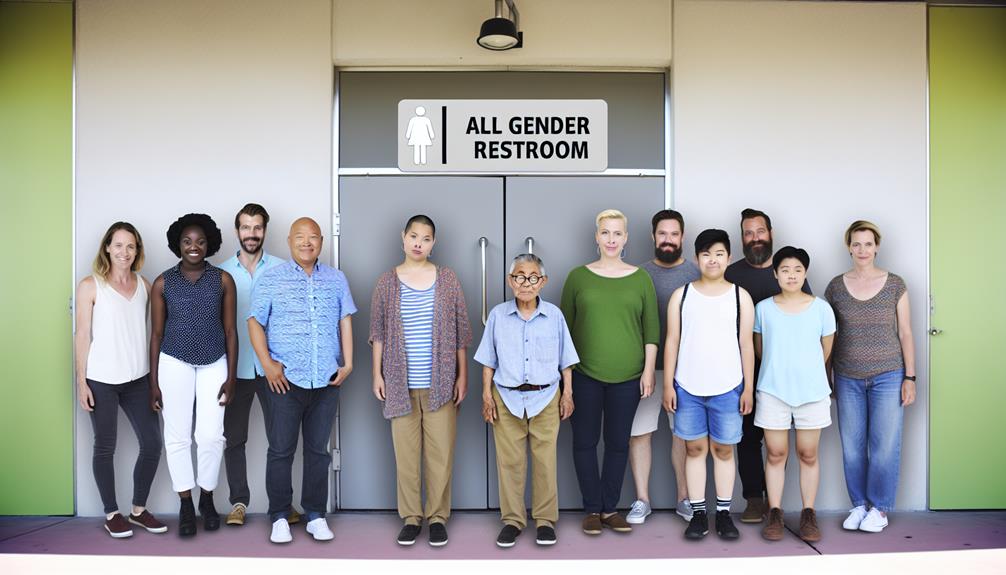Privacy, Dignity, and Rights: The Transgender Bathroom Controversy


Table of Contents
ToggleAmidst the transgender bathroom debate, misconceptions cloud the issue. Studies show no increased risk with transgender restroom use. Gender-inclusive facilities foster well-being. Equal access to bathrooms is a human right. Discrimination prevention is crucial. Transphobic policies in schools lead to bullying. Advocating for gender identity rights guarantees inclusivity. Media manipulation distorts reality. Safety isn't compromised by transgender restroom use. Understanding is key for respect. Get insights on legal implications, human rights, and dispelling myths for a clearer perspective.
Public perception often distorts safety concerns surrounding transgender restroom use, fueled by fear-mongering tactics from hate groups. Risk perception regarding transgender individuals using restrooms is inflated, leading to unnecessary anxiety and discrimination. In reality, studies indicate that there's no increased safety risk associated with transgender restroom use. Safety measures, such as providing gender-inclusive facilities, are essential to guarantee the well-being of all individuals.
Media influence plays a significant role in shaping community attitudes towards transgender restroom use. Misinformation spread by certain outlets can amplify fear and prejudice. Effective communication strategies, rooted in facts and empathy, are critical in combating these misconceptions. By promoting understanding and acceptance, society can create a more inclusive environment for transgender individuals.
It is crucial to address these misconceptions and educate the public on the importance of respecting transgender rights. By debunking myths and advocating for gender-inclusive policies, we can foster a safer and more supportive community for everyone.
Addressing misconceptions and advocating for gender-inclusive policies are vital to upholding legal rights and promoting human dignity for all individuals. Ensuring equal bathroom access for transgender individuals isn't only a matter of social justice but also a fundamental human right. Discrimination prevention plays an essential role in creating a safe and inclusive environment where everyone can freely express their gender identity without fear of prejudice.
Equality advocacy is necessary in combating discrimination based on gender identity and promoting a society that values diversity and inclusivity. Legal rights protect individuals from being denied access to restrooms that correspond with their gender identity. By prioritizing equality and inclusivity in restroom policies, society can take a significant step towards fostering a more accepting and supportive environment for all individuals.
Fighting transphobic policies in schools is crucial in creating a safe and inclusive environment for all students. Transphobic policies can have damaging effects on student well-being, educational impact, mental health, and social inclusion.
Here are three key points to ponder:
Shifting from the impact of transphobic policies in schools, advocating for gender identity rights is vital in guaranteeing a safe and inclusive environment for all individuals. Bathroom accessibility is a fundamental aspect of gender inclusivity, where individuals can access facilities aligning with their gender identity without fear of discrimination. Identity affirmation through proper restroom use not only fosters a sense of belonging but also prevents discrimination and upholds respect for all individuals.
Advocacy efforts play a pivotal role in promoting gender identity rights and creating inclusive spaces where everyone feels accepted. By advocating for equal restroom access, individuals can feel validated in their identities and experience a sense of safety and security. Discrimination prevention is at the heart of these advocacy efforts, aiming to dismantle harmful stereotypes and ensure that all individuals, regardless of their gender identity, are treated with dignity and respect.
To clarify misunderstandings and correct false information regarding transgender individuals, it's important to debunk common myths and misconceptions surrounding their access to restroom facilities.
When gender-neutral restrooms are absent, transgender individuals navigate restroom access by seeking gender affirmation, respecting restroom etiquette, addressing privacy concerns, and utilizing legal protections. They challenge cultural norms by advocating for inclusive facilities.
Respecting individual identity and safety is vital, emphasizing the importance of creating welcoming environments for all. By promoting understanding and acceptance, society can guarantee equal rights and dignity for transgender individuals in restroom access.
Schools can implement supportive policies to create safe environments for all students. These policies should include offering resources and training programs to educate staff and students on transgender rights and foster understanding. Additionally, schools can engage in advocacy efforts and form community partnerships to promote equality and support for transgender students facing restroom discrimination.
Public campaigns raise awareness and workplace training fosters understanding of transgender individuals in restroom settings. Community outreach promotes acceptance, while policy advocacy and allyship education encourage support for gender diversity. These initiatives aim to create safe and welcoming environments for all individuals, emphasizing respect and equality.
Initiatives like these play a vital role in promoting awareness and acceptance of transgender individuals in restroom settings.
Businesses and public facilities can guarantee safe and inclusive restroom environments by implementing clear restroom signage indicating gender-neutral or all-gender facilities. Conducting staff training on diversity, inclusion, and respectful behavior is vital.
Community support through education and awareness campaigns can help foster acceptance. Policies should be established that prioritize inclusivity and safety for all individuals. Accessibility measures like providing adequate facilities for people with disabilities are essential for creating welcoming spaces.
Individuals can educate themselves and others on the importance of respecting transgender individuals' right to access restrooms aligning with their gender identity through ally training, community outreach, gender education, policy advocacy, and respectful dialogue.
By engaging in these practices, people can foster understanding, promote inclusivity, and advocate for equal rights.
Such efforts contribute to creating safe and supportive environments for all individuals, regardless of their gender identity.
To sum up, it's crucial to challenge the misconceptions and fears surrounding the transgender bathroom debate in order to create a more inclusive and accepting society.
By advocating for gender identity rights and debunking myths, we can foster understanding and support for all individuals.
Let's work towards creating safe and welcoming environments for everyone, where human rights are upheld and discrimination is dismantled.
Together, we can promote equality and respect for all.
 Featured PostsOctober 31, 2025Debunking the Trans Shooter Myth: Separating Facts From Fear
Featured PostsOctober 31, 2025Debunking the Trans Shooter Myth: Separating Facts From Fear Fashion and ExpressionOctober 31, 2025Affordable Clothing Tips for Masculine Presentation (FTM)
Fashion and ExpressionOctober 31, 2025Affordable Clothing Tips for Masculine Presentation (FTM) Featured PostsOctober 30, 2025Culture, Conversation, and Change: What’s Behind the Dip in Trans Identification Among Teens?
Featured PostsOctober 30, 2025Culture, Conversation, and Change: What’s Behind the Dip in Trans Identification Among Teens? Featured PostsOctober 30, 2025Can a 3-Year-Old Know They’re Trans? Understanding Gender at an Early Age
Featured PostsOctober 30, 2025Can a 3-Year-Old Know They’re Trans? Understanding Gender at an Early Age